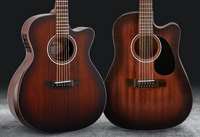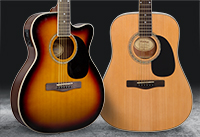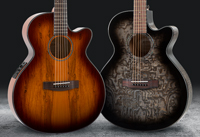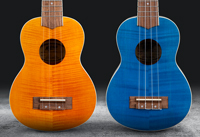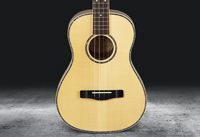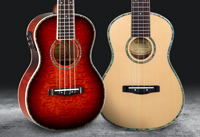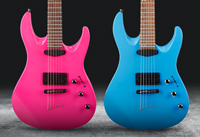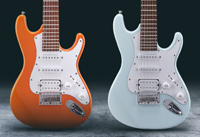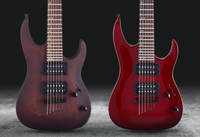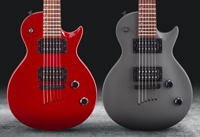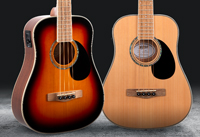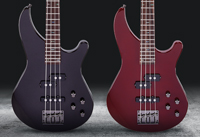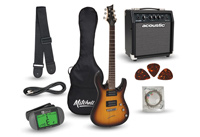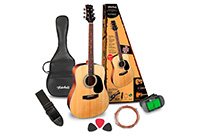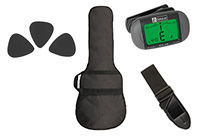Bass Player Review: Mitchell FB700 & TB500 Basses
Posted 02/23/2017 by Tarik Ragab
“A rising tide lifts all boats.”
The modern era has facilitated massive changes in the consumption of manufactured goods. Automation lowers production costs, hastening and increasing output. For niche markets, optimization gives consumers more access to formerly high-end products. In the case of electric basses, both the professional and budding student benefit: For the working pro, custom and boutique instruments are often cost-prohibitive, and for the student, access to better-sounding and playing basses can help inspire dedication to the craft.
In the spirit of this democratization of quality, Mitchell Guitars has introduced two basses—the FB700 Fusion and TB500 Traditional —that sport premium features usually attached to much higher price tags. Both come in 4- and 5-string versions, with the FB700 adding a 6-string variant. Our FB700 tester was a 4-string with 24 jumbo frets, while our test TB500 was a 20-fret 5’er.
FB700
The FB700’s mahogany body is nicely carved; it’s somewhat reminiscent of a Fodera Monarch or Yin Yang. A thin, flat quilted-maple veneer covers a large portion of the body, but does not follow its contours. Both the FB700 and the TB500 bolt-on necks are contoured at the joint for unimpeded high-fret access. The boutique-style FB700’s vertically laminated contrasting neck woods are a high-end touch that improves stability. The FB700’s six-bolt neck joint ensures a solid connection to the body for maximum resonance. With an even more extreme taper than a traditional Jazz-style neck, the FB700’s neck is thin at the nut. Our tester’s rosewood fingerboard had lustrous mother-of-pearl inlays and near-perfect fretwork. Mitchell angles back the 2+2 headstock to create downward pressure on the nut and improve tuning stability. The hardware is generic, but functional.
The MM-style pickups on the FB700 are dual MB4 paraffin-dipped Alnico V humbuckers and, not surprisingly, have a StingRay-esque sonic palette. With the pickup blended and 3-band EQ flat, the bass’ natural sound is bright and punchy. The bridge pickup is particularly nasal and bright. Blending in the neck pickup added more bark—it sounded great with a pick. The neck pickup rounded things out considerably and brought out deeper warmth. I dug that cranking the lows still resulted in a useful tone, given that a lot of the beginners who pick up this bass may not understand EQ. The bright personality meant I had to roll back the highs and mids almost completely to bring out the rounder tone, though.
Overall, the FB700 has a bright, contemporary sound, great for slapping or more aggressive hard-rock pickstyle playing.
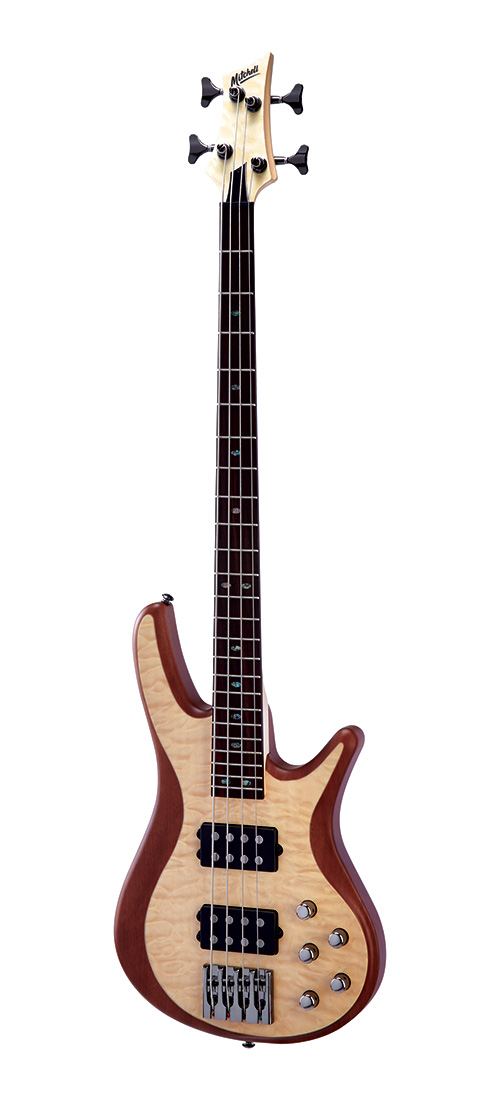
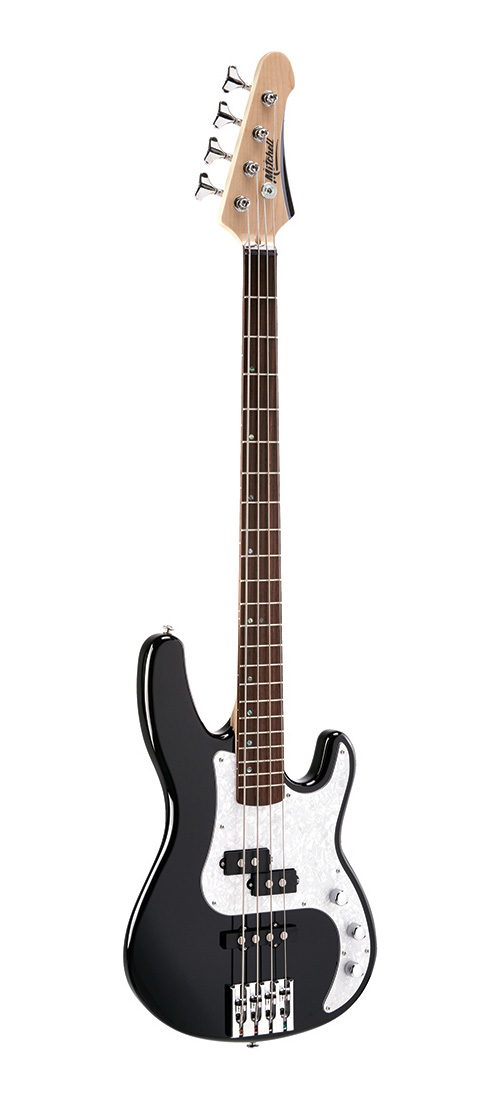
TB500
Like the FB700, the TB500’s body is well carved, featuring an angled jack sunken fairly deep into the side. The input jack sat too close to the strap button, though, making it tough to run a cable through the strap to avoid disconnection, although Mitchell says the design helps prevent errant unplugging. The TB500’s neck is narrow at the nut, making the B- and E-string spacing tight in the 1st position. The offset MOP inlays were a nice touch, but there was some finish compound still visible on the fingerboard that needed to be buffed out. The TB500’s neck was too straight out of the box, but a slight trussrod adjustment quickly remedied it. The headstock-located trussrod is deeply sunk into its channel, making it difficult to engage an allen wrench without risk of stripping the nut. Nonetheless, the neck responded well to the adjustment and played great after that.
The P/J configuration appeals to the player who wants the buttery roundness of a P-style bass and the punch of a J. The passive TB500 has a much lower output than the FB700, but it’s warmer, with a more prominent midrange. Turning up the tone knob brought out some P-style clack. The TB500’s warmer sound made it just right for the more traditional rock, pop, and blues player.
While mass production has ushered in the era of disposable goods, it is nice to see in these basses a counterbalance to the trend. Leveraging technology to offer access to high-performance instruments can make modernity work for all.
FB700 SPECIFICATIONS
Construction Bolt-on
Body Mahogany
Top Quilted-maple veneer
Fingerboard Rosewood
Frets 24
Scale length 34″
Neck width at nut 38mm
String spacing 19mm
Pickups Dual MB4 paraffin-dipped Alnico V humbuckers
Preamp Active with 3-band EQ
TB500 SPECIFICATIONS
Construction Bolt-on
Body Alder
Fingerboard Maple
Frets 20
Scale length 34″
Neck width at zero-fret 45mm
String spacing 17mm
Pickups Neck, split-coil P-style Alnico V; bridge, single-coil J-style Alnico V
Bass Player Review: Mitchell FB700 & TB500 Basses
Posted 02/23/2017 by Tarik Ragab
“A rising tide lifts all boats.”
The modern era has facilitated massive changes in the consumption of manufactured goods. Automation lowers production costs, hastening and increasing output. For niche markets, optimization gives consumers more access to formerly high-end products. In the case of electric basses, both the professional and budding student benefit: For the working pro, custom and boutique instruments are often cost-prohibitive, and for the student, access to better-sounding and playing basses can help inspire dedication to the craft.
In the spirit of this democratization of quality, Mitchell Guitars has introduced two basses—the FB700 Fusion and TB500 Traditional —that sport premium features usually attached to much higher price tags. Both come in 4- and 5-string versions, with the FB700 adding a 6-string variant. Our FB700 tester was a 4-string with 24 jumbo frets, while our test TB500 was a 20-fret 5’er.

FB700
The FB700’s mahogany body is nicely carved; it’s somewhat reminiscent of a Fodera Monarch or Yin Yang. A thin, flat quilted-maple veneer covers a large portion of the body, but does not follow its contours. Both the FB700 and the TB500 bolt-on necks are contoured at the joint for unimpeded high-fret access. The boutique-style FB700’s vertically laminated contrasting neck woods are a high-end touch that improves stability. The FB700’s six-bolt neck joint ensures a solid connection to the body for maximum resonance. With an even more extreme taper than a traditional Jazz-style neck, the FB700’s neck is thin at the nut. Our tester’s rosewood fingerboard had lustrous mother-of-pearl inlays and near-perfect fretwork. Mitchell angles back the 2+2 headstock to create downward pressure on the nut and improve tuning stability. The hardware is generic, but functional.
The MM-style pickups on the FB700 are dual MB4 paraffin-dipped Alnico V humbuckers and, not surprisingly, have a StingRay-esque sonic palette. With the pickup blended and 3-band EQ flat, the bass’ natural sound is bright and punchy. The bridge pickup is particularly nasal and bright. Blending in the neck pickup added more bark—it sounded great with a pick. The neck pickup rounded things out considerably and brought out deeper warmth. I dug that cranking the lows still resulted in a useful tone, given that a lot of the beginners who pick up this bass may not understand EQ. The bright personality meant I had to roll back the highs and mids almost completely to bring out the rounder tone, though.
Overall, the FB700 has a bright, contemporary sound, great for slapping or more aggressive hard-rock pickstyle playing.

TB500
Like the FB700, the TB500’s body is well carved, featuring an angled jack sunken fairly deep into the side. The input jack sat too close to the strap button, though, making it tough to run a cable through the strap to avoid disconnection, although Mitchell says the design helps prevent errant unplugging. The TB500’s neck is narrow at the nut, making the B- and E-string spacing tight in the 1st position. The offset MOP inlays were a nice touch, but there was some finish compound still visible on the fingerboard that needed to be buffed out. The TB500’s neck was too straight out of the box, but a slight trussrod adjustment quickly remedied it. The headstock-located trussrod is deeply sunk into its channel, making it difficult to engage an allen wrench without risk of stripping the nut. Nonetheless, the neck responded well to the adjustment and played great after that.
The P/J configuration appeals to the player who wants the buttery roundness of a P-style bass and the punch of a J. The passive TB500 has a much lower output than the FB700, but it’s warmer, with a more prominent midrange. Turning up the tone knob brought out some P-style clack. The TB500’s warmer sound made it just right for the more traditional rock, pop, and blues player.
While mass production has ushered in the era of disposable goods, it is nice to see in these basses a counterbalance to the trend. Leveraging technology to offer access to high-performance instruments can make modernity work for all.
FB700 SPECIFICATIONS
Construction Bolt-on
Body Mahogany
Top Quilted-maple veneer
Fingerboard Rosewood
Frets 24
Scale length 34″
Neck width at nut 38mm
String spacing 19mm
Pickups Dual MB4 paraffin-dipped Alnico V humbuckers
Preamp Active with 3-band EQ
TB500 SPECIFICATIONS
Construction Bolt-on
Body Alder
Fingerboard Maple
Frets 20
Scale length 34″
Neck width at zero-fret 45mm
String spacing 17mm
Pickups Neck, split-coil P-style Alnico V; bridge, single-coil J-style Alnico V

